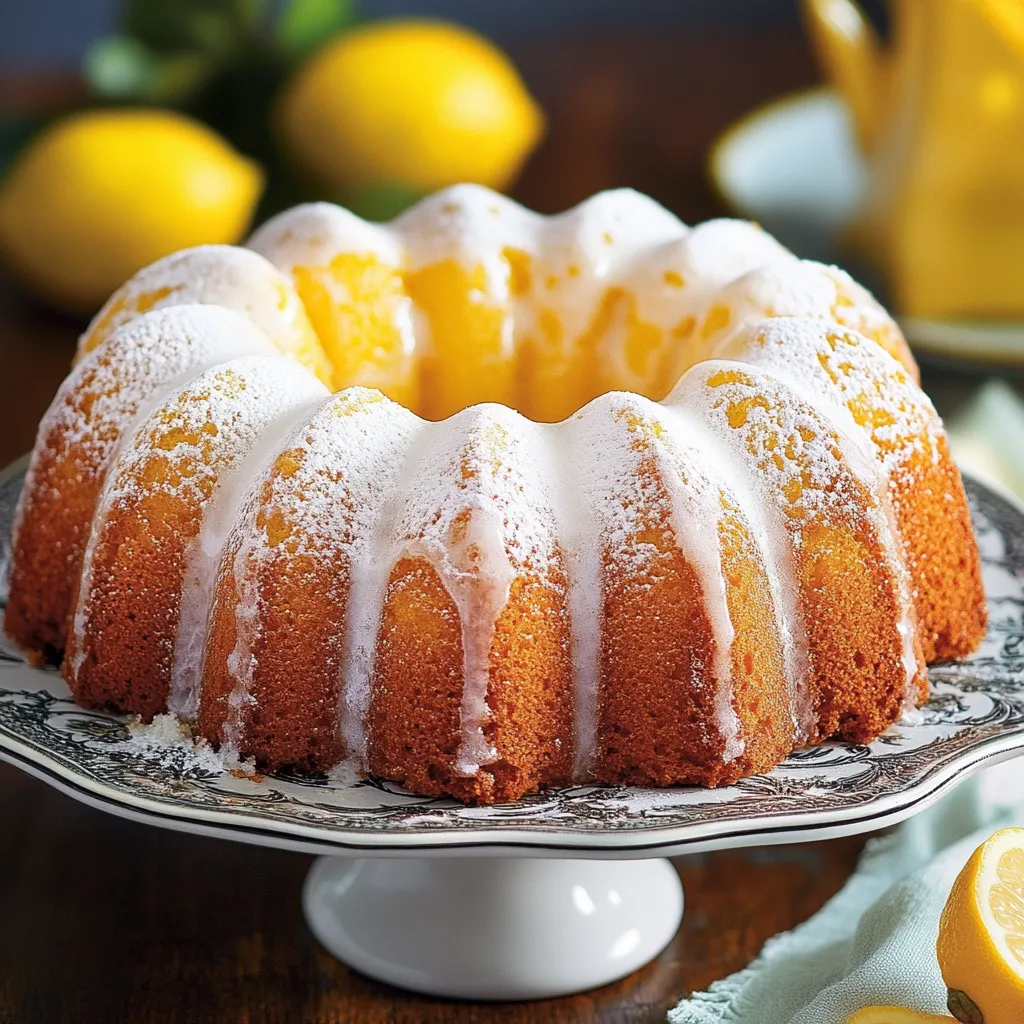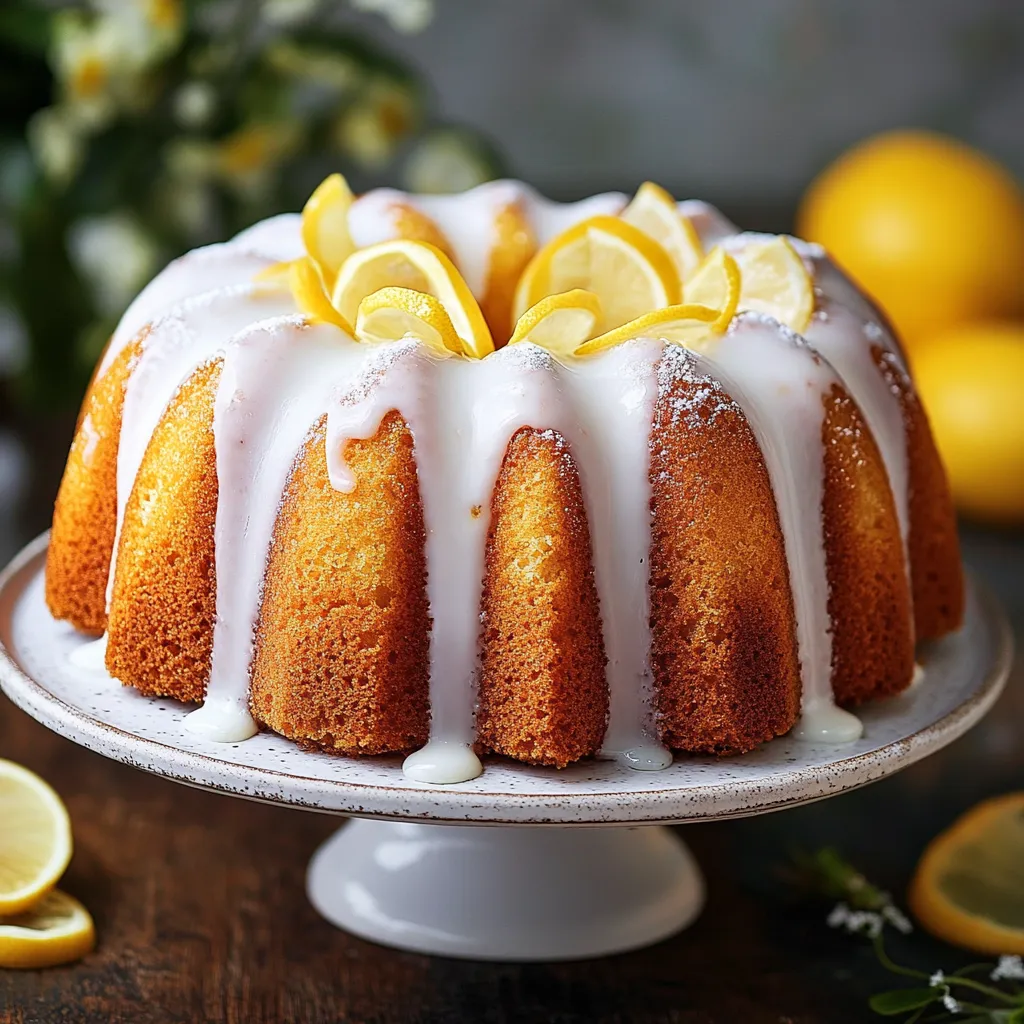 Pin
Pin
This lemon bundt cake delivers the perfect balance of bright citrus flavor and moist, tender crumb. Each slice offers a buttery richness complemented by fresh lemon in both the cake and glaze, creating a dessert that's both elegant and comforting.
I first made this cake for a spring brunch and watched as guests returned for second slices before the meal was even finished. Now it's my go-to dessert whenever I need something foolproof yet impressive.
Ingredients
- All purpose flour: Provides structure while cake flour ensures tenderness
- Fresh lemon zest: From 6 lemons, contains essential oils that infuse intense flavor
- Sour cream: Adds moisture and tanginess that balances the sweetness perfectly
- Melted butter: Rather than creamed butter, creates a uniquely rich texture
- Powdered sugar: In the glaze, dissolves completely for a smooth finishing touch
Step-by-Step Instructions
- Prepare the Dry Ingredients:
- Sift together both flours, baking powder, and salt in a large bowl. This step removes any lumps and aerates the flour, which contributes to the cake's light texture. Take your time with this process as it creates the foundation for the cake's structure.
- Create the Lemon Sugar:
- Process sugar with fresh lemon zest in a food processor. This technique releases the essential oils from the zest, infusing the sugar with intense lemon flavor that permeates the entire cake. The sugar will become slightly moist and incredibly fragrant.
- Mix the Wet Ingredients:
- Add lemon juice, eggs, and sour cream to the lemon sugar, then slowly drizzle in melted butter while mixing. The gradual addition of butter creates an emulsion that prevents the batter from separating. Make sure your melted butter has cooled slightly so it doesn't cook the eggs.
- Combine Wet and Dry:
- Pour the wet ingredients into the dry ingredients and fold gently just until combined. Overmixing activates gluten and toughens the cake, so use a light hand and stop when you no longer see dry flour. The batter will seem somewhat thin, which is exactly right.
- Prepare the Bundt Pan:
- Thoroughly grease every crevice of your bundt pan. Use a pastry brush to reach all areas, especially in ornate pans. This detailed preparation ensures your cake will release cleanly after baking, preserving the beautiful pattern.
- Bake to Perfection:
- Bake until a toothpick comes out clean or with a few moist crumbs, about 50-60 minutes. If the top browns too quickly, tent loosely with foil. The cake needs this full baking time to set properly through to the center.
 Pin
Pin
The combination of both all-purpose and cake flour is my secret weapon in this recipe. I discovered this technique years ago when trying to create the perfect texture that would hold up to the moisture from all that lemon juice while still remaining tender.
Perfect Your Lemon Selection
Choose bright yellow lemons with thin, oily skins for maximum zest yield. Avoid lemons with thick, bumpy rinds as they typically contain less juice and essential oils. Roll each lemon firmly on the counter before juicing to break the membranes inside and release more juice. Meyer lemons work beautifully in this recipe during their season, offering a sweeter, more complex flavor profile.
Make-Ahead Options
This cake actually improves with a day of rest as the flavors meld and intensify. You can bake the cake up to two days before serving and add the glaze just a few hours before your event. For longer storage, freeze the unglazed cake wrapped tightly in plastic wrap and foil for up to three months. Thaw overnight at room temperature before glazing and serving.
Flavor Variations
Transform this versatile recipe by adding complementary flavors that enhance the lemon base. Fold in 1-2 tablespoons of poppy seeds for a classic combination with pleasant texture contrast. Add 1 teaspoon of dried lavender flowers to the lemon sugar for a sophisticated floral note. For a berry twist, gently fold 1 cup of fresh blueberries dusted with flour into the final batter before baking.
Troubleshooting Tips
If your bundt cake sticks despite greasing, place a hot, damp kitchen towel over the pan for 5 minutes, which creates steam that helps release the cake. For a thicker glaze that creates dramatic drips, reduce the liquid and allow it to set slightly before applying. If your cake browns too quickly during baking, tent it with foil after the first 30 minutes to protect the top.
Recipe Questions & Answers
- → How do I prevent the bundt cake from sticking to the pan?
Make sure to grease the pan thoroughly using a nonstick cooking spray or melted shortening. Use a pastry brush to cover every nook and cranny of the bundt pan before pouring in the batter.
- → Can I use yogurt instead of sour cream?
Yes, full-fat unsweetened plain yogurt can be substituted for sour cream, offering a similar moist and rich texture to the cake.
- → How do I make the glaze thicker or thinner?
To thicken the glaze, add more powdered sugar. To make it thinner, add a little more lemon juice or milk until your desired consistency is reached.
- → How can I check if the cake is fully baked?
Insert a toothpick into the center of the cake. If it comes out clean or with a few moist crumbs attached, the cake is done.
- → How should I store the cake?
Cover the glazed cake with foil or plastic wrap and store it at room temperature for up to 2 days. For longer storage, it can be refrigerated for up to a week.